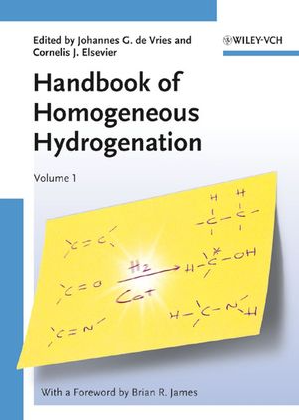

❞ كتاب The Handbook of Homogeneous Hydrogenation : Chapter 24 ❝
This multi-volume handbook is the first to cover all questions concerning homogeneous hydrogenation. As such, it presents the catalysts, the scope of their application, mechanistic aspects, asymmetric methods, combinatorials catalysis, recycling methods and industrial examples. In 45 clearly structured chapters, the book includes all hydrogenation reactions catalyzed by soluble transition metal-based catalysts. All authors adopt an applied approach, emphasizing those aspects important for industrial use.
هذا الكتيب متعدد المجلدات هو أول من يغطي جميع الأسئلة المتعلقة الهدرجة المتجانسة. على هذا النحو ، فإنه يعرض العوامل الحفازة ، ونطاق تطبيقها ، والجوانب الميكانيكية ، والطرق غير المتماثلة ، والتحفيز التوافقي ، وطرق إعادة التدوير ، والأمثلة الصناعية. في 45 فصلاً منظمًا بشكل واضح ، يشتمل الكتاب على جميع تفاعلات الهدرجة المحفز بواسطة المحفزات القابلة للذوبان القائمة على المعادن القابلة للذوبان. يعتمد جميع المؤلفين نهجًا تطبيقيًا ، مع التركيز على هذه الجوانب المهمة للاستخدام الصناعي.
With some 2,000 illustrations and 50 tables, this is a must-have for everyone working in the chemicals and pharmaceutical industries, as well as for graduate students in chemistry.
مع حوالي 2000 رسم توضيحي و 50 جدول ، هذا أمر لا بد منه لكل من يعمل في الصناعات الكيميائية والصيدلانية ، وكذلك لطلاب الدراسات العليا في الكيمياء.
Homogeneous hydrogenation is one of the most thoroughly studied fields of homogeneous catalysis. The results of these studies have proved to be most important for an understanding of the underlying principles of the activation of small molecules by transition metal complexes.
الهدرجة المتجانسة هي واحدة من أكثر مجالات الحفز المتجانس درسًا بدقة. أثبتت نتائج هذه الدراسات أنها الأكثر أهمية لفهم المبادئ الأساسية لتنشيط الجزيئات الصغيرة عن طريق مجمعات المعادن الانتقالية.
Hydrogenation – meaning, to treat with hydrogen – is a chemical reaction between molecular hydrogen (H2) and another compound or element, usually in the presence of a catalyst such as nickel, palladium or platinum. The process is commonly employed to reduce or saturate organic compounds. Hydrogenation typically constitutes the addition of pairs of hydrogen atoms to a molecule, often an alkene. Catalysts are required for the reaction to be usable; non-catalytic hydrogenation takes place only at very high temperatures. Hydrogenation reduces double and triple bonds in hydrocarbons.
والهدرجة - بمعنى المعالجة بالهيدروجين - عبارة عن تفاعل كيميائي بين الهيدروجين الجزيئي (H2) ومركب أو عنصر آخر ، عادة في وجود محفز مثل النيكل أو البلاديوم أو البلاتين. يتم استخدام العملية بشكل شائع لتقليل أو تشبع المركبات العضوية. يشكل الهدرجة عادة إضافة أزواج من ذرات الهيدروجين إلى جزيء ، غالبًا ألكين. المحفزات مطلوبة ليكون رد الفعل قابلاً للاستخدام ؛ يحدث الهدرجة غير الحفزية فقط عند درجات حرارة عالية جدًا. يقلل الهدرجة من الروابط الثنائية والثلاثية في الهيدروكربونات.
It has three components, the unsaturated substrate, the hydrogen (or hydrogen source) and, invariably, a catalyst. The reduction reaction is carried out at different temperatures and pressures depending upon the substrate and the activity of the catalyst.
يحتوي على ثلاثة مكونات ، الركيزة غير المشبعة ، الهيدروجين (أو مصدر الهيدروجين) ، ودائمًا ، محفز. يتم تنفيذ تفاعل الاختزال عند درجات حرارة وضغوط مختلفة حسب الركيزة ونشاط المحفز. -
من كتب الهندسة - مكتبة كتب الهندسة والتكنولوجيا.

 قبل تحميل الكتاب ..
قبل تحميل الكتاب .. 
 منصّة المكتبة
منصّة المكتبة 